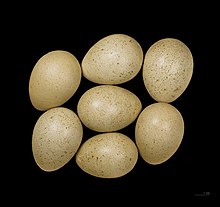Barbary partridge
| Barbary Partridge | |
|---|---|

| |
| Scientific classification | |
| Kingdom: | |
| Phylum: | |
| Class: | |
| Order: | |
| Family: | |
| Subfamily: | |
| Genus: | |
| Species: | A. barbara
|
| Binomial name | |
| Alectoris barbara (Bonnaterre, 1791)
| |

The Barbary Partridge (Alectoris barbara), is a gamebird in the pheasant family Phasianidae of the order Galliformes, gallinaceous birds.
Description
This partridge has its main native range in North Africa, and is also native to Gibraltar[1] and the Canary Islands (Ssp Alectoris barbara koenigi).[2] It has been introduced to Portugal and Madeira, though there are no recent records of this species on the latter islands. It is also present in Sardinia. It is closely related to its western European equivalent, the Red-legged Partridge (Alectoris rufa).
This 33–36 cm bird is a resident breeder in dry, open and often hilly country. It nests in a scantily lined ground scrape laying 10-16 eggs. The Barbary Partridge takes a wide variety of seeds and some insect food.
The Barbary Partridge is a rotund bird, with a grey-brown back, grey breast and buff belly. The face is light grey with a broad reddish-brown gorget. It has rufous-streaked white flanks and red legs. When disturbed, it prefers to run rather than fly, but if necessary it flies a short distance on rounded wings.
It is similar to the Red-legged Partridge, but it has a different head and neck pattern. The song is a noisy tre-tre-tre-tre-tre-cheeche-tre-tre-tre.
The Barbary Partridge is the national bird of Gibraltar.[3]
Notes
- ^ "The Gibraltar Bird List: Bird species observed in or from the territory of Gibraltar". Gibraltar Ornithological & Natural History Society. Retrieved 2007-07-24.
- ^ Template:Es icon Martín P., Cardona A., Avifauna Canaria II, Aves de las Zonas Bajas p 55
- ^ "Gibraltar's Culture and Customs". Retrieved 3 August 2011.
References
- Template:IUCN2006 Database entry includes justification for why this species is of least concern
External links
- IBC Videos

